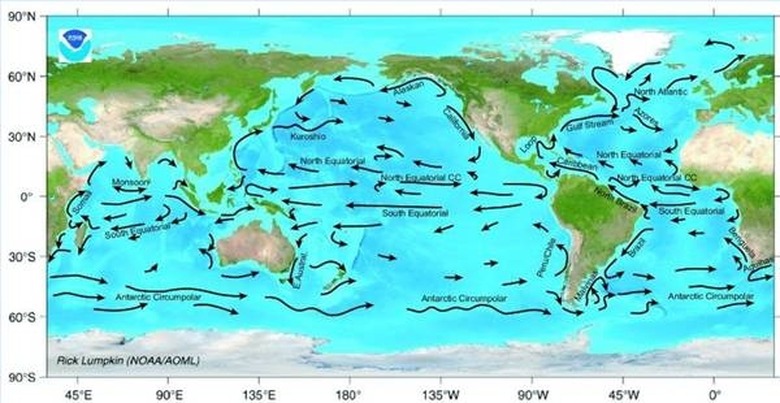What Are Surface Currents Caused By?
Although ocean circulation isn't visible to the eye, it's one of the most important climate regulators on the planet, and it's vital for the survival of marine life. If you're looking for a surface current definition, it is any current that extends to a depth of about 400 meters. Sailors must account for surface ocean currents when planning routes to avoid being swept off-course. Some of these currents are but local eddies, but others are huge. The Gulf Stream, which flows in the North Atlantic, is a surface current that carries 4,500 times more water than the Mississippi River. A number of natural conditions and processes generate ocean surface currents, including wind, temperature gradients, gravity, differences in salinity and earthquakes.
The Effect of Wind on Water Current
The Effect of Wind on Water Current
Anyone who has observed a lake on a windy day can't help but be impressed by the visible effect it has on the water surface. Wind generates waves that crash against landforms and obstacles in the water, generally turning the placid surface into a cauldron of activity. The visible wave motion also generates a water current below the surface, and if you go swimming on a windy day, you'll be able to feel this current.
The same thing happens when powerful winds generate surface activity on the oceans. Some of the winds are perpetual planetary features, generated by a combination of the Coriolis Effect, which is a result of the Earth's rotation, and temperature differences between cold Arctic air and warm tropical air. These winds are called the trade winds. They blow at 30 degrees of latitude north and south, and they help drive such large ocean currents as the Gulf Stream. In addition, winds generated by storms contribute to temporary currents that occur in various places.
Temperature Differences in the Oceans
Temperature Differences in the Oceans
When warm and cold air meet each other, the warm air rises, cold air passes underneath it and the result is a wind current. A similar thing happens when warm water meets cold water in the oceans, but instead of wind, the interaction produces a water current. Because the ocean temperature is less uniform at the surface than in the depths, the currents that arise because of temperature differences are generally surface ocean currents. Heat from the sun is the prime contributor to the temperature gradient that drives ocean circulation.
Dense Water Sinks While Less-Dense Water Rises
Dense Water Sinks While Less-Dense Water Rises
Warm water rises because it's less dense than cold water, so gravity has a part in the production of ocean currents. Cold water weighs more per unit volume than warm water, so gravity exerts a greater force on it. Salinity also affects density, and it too has a hand in creating surface ocean currents. The average salinity of sea water is 35 parts per thousand, or about 3.5 percent. That number fluctuates for a variety of reasons, and one of the most important is the addition of fresh water at the mouths of large rivers. For example, the outflow of water from Amazon river is so strong that it can be seen from space stretching hundreds of kilometers into the Atlantic Ocean.
Cite This Article
MLA
Deziel, Chris. "What Are Surface Currents Caused By?" sciencing.com, https://www.sciencing.com/what-surface-currents-caused-5003471/. 30 July 2018.
APA
Deziel, Chris. (2018, July 30). What Are Surface Currents Caused By?. sciencing.com. Retrieved from https://www.sciencing.com/what-surface-currents-caused-5003471/
Chicago
Deziel, Chris. What Are Surface Currents Caused By? last modified March 24, 2022. https://www.sciencing.com/what-surface-currents-caused-5003471/
